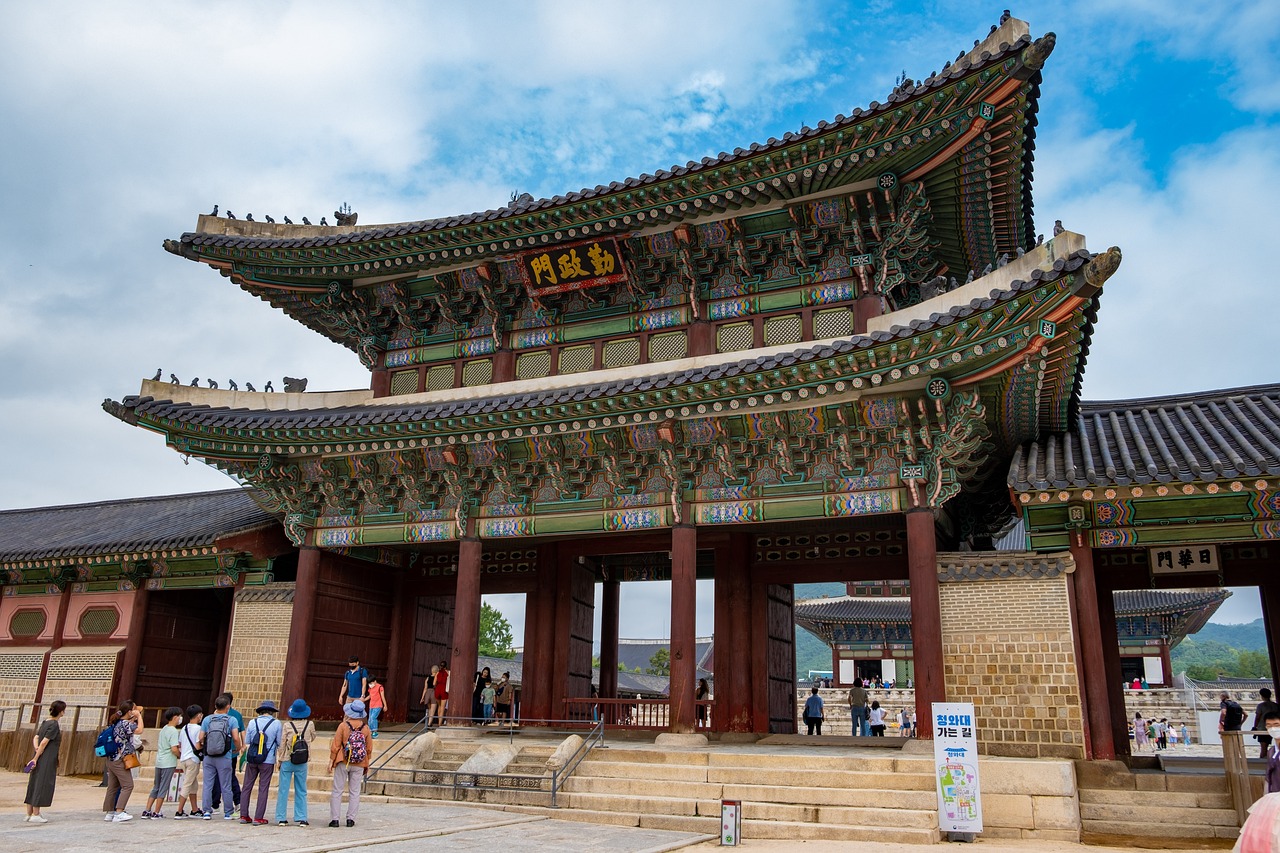Immerse yourself in Asia’s vibrant history by exploring the resplendent Gyeongbokgung Palace. A majestic testament to Korea’s enduring architectural and historical heritage, this ancient palace epitomizes the time-honored culture and resilience of the nation. Located centrally within Seoul’s heart, this formidable landmark, which bore witness to Korea’s turbulent past and the Joseon Dynasty’s grandeur, has been painstakingly restored, embodying the bygone era’s splendor. Today, Gyeongbokgung Palace, often frequented by tourists and architecture enthusiasts, proudly showcases traditional Korean architectural aesthetics. With easy access via several transport modes and enchanting sites like Gwanghwamun Gate and the National Palace Museum of Korea to explore, this Korean treasure is a must-visit. Be sure to plan your visit in the picturesque spring or autumn season, and don’t forget to witness the captivating Changing of the Guard Ceremony.

Significance of Gyeongbokgung Palace
Historical background
Gyeongbokgung Palace, also known as the “Palace Greatly Blessed by Heaven,” holds a significant historical value in South Korea. Built in 1395, the palace serves as a symbol of the nation’s rich past and reflects the power and prosperity of the Joseon Dynasty.
Role during the Joseon Dynasty
During the Joseon Dynasty, Gyeongbokgung Palace held a significant role by being the main royal palace of the period. The palace’s grandeur was seen as a representation of the authority and influence of the reigning dynasty at that time.
Damage during Japanese invasions and occupation
Unfortunately, the palace faced heavy damage during the Japanese invasions of Korea and a subsequent Japanese occupation from 1910 to 1945. This ravage not only devastated the physical structure but also led to a loss of significant tangible cultural heritage.
Restoration efforts post-1945
The liberation of Korea from Japanese rule in 1945 initiated a movement to restore the palace to its original glory. Significant restoration work has been done and continues to this day, aiming to revamp and preserve the palace’s historical assets.
Architectural Highlights of Gyeongbokgung Palace
Characteristics of traditional Korean architecture
Gyeongbokgung Palace offers a glimpse into traditional Korean architecture. You’ll find an exquisite amalgamation of beautiful courtyards, intricate woodwork, and the unique Dancheong painting that adorns the structures.
Important constructions within the palace complex
Several unique constructions within the palace draw numerous visitors each year. Each structure has its own significance, contributing to the palace’s overall aesthetic, cultural, and historical value.
Description of architectural styles and motifs
From the curved roofs adorned with decorative tiles to the symmetrical patterns etched into the woodwork, the palace showcases a range of architectural styles intrinsic to Korean tradition.

Location and Accessibility
Geographical location in Seoul
Situated in the heart of Seoul, the capital city of South Korea, Gyeongbokgung Palace is easily accessible and is close to other major attractions of the city.
Modes of transportation to reach the palace
You can reach the palace through various modes of transportation. Subway and bus connections are available, and you can also use taxis or private vehicles. Some prefer walking or cycling when the weather permits.
Closest subway and bus stations
The closest subway station is Gyeongbokgung Station, and several bus routes also lead to the palace.
Ideal Time to Visit
Weather conditions during spring (April-June)
Springtime, from April to June, is a great time to visit Gyeongbokgung Palace. Moderate weather conditions and blooming flowers around the premises enchants the visitors, adding to the beauty of the palace.
Scenic beauty during autumn (September-November)
Visiting the palace during autumn, between September and November, is also recommended. The golden hues of falling leaves paired with a clear sky provide a picturesque setting, perfect for a leisurely stroll.
Other favorable times of the year
Albeit spring and autumn are the best seasons, the palace is ready to amaze you with its charm throughout the year.

Potential Visitors
Who might be interested in visiting?
History and culture enthusiasts, tourists, families, photography enthusiasts, and students or scholars studying Korean history or culture are likely to find Gyeongbokgung Palace a fascinating place to visit.
Tours and programs for schools and educational institutes
Multiple tours and programs are available for schools and educational institutes, providing valuable insights into Korean history, culture, and architecture.
Recommendations for history and culture enthusiasts
If you’re a history or culture aficionado, Gyeongbokgung Palace is a must-visit. It offers a deep dive into the Joseon Dynasty’s era, letting you grasp the richness of Korean history.
Tips for photography enthusiasts
For those blessed with a knack for photography, the palace offers a myriad of photo opportunities. The Changing of the Guard Ceremony can make for some engaging action shots, while the various architectural details can serve as subjects of still-life photography.
Main Attractions within the Palace
Detailed explanation of key sites within the palace complex
The palace complex boasts multiple key sites, each with its own historical significance and tale to tell. Explore them all to truly understand the cultural depth of Gyeongbokgung Palace.
Description and significance of Gwanghwamun Gate
Gwanghwamun Gate is the main gate of the palace. It’s an impressive structure that gives you a taste of the grandeur that lies within the palace.
Features of Geunjeongjeon Hall
Geunjeongjeon Hall was a place where important political affairs were conducted during Joseon Dynasty. Walk through this hall to get a feel for the weight of decisions made within its walls.
Importance of Gyeonghoeru Pavilion
Gyeonghoeru Pavilion is a beautiful pavilion placed over a serene pond. This was the venue for royal banquets and adds an element of tranquility to the vibrant palace.
What to see at the National Palace Museum of Korea
Adjacent to the palace, the National Palace Museum of Korea houses a multitude of artifacts from the Joseon Dynasty, enriching your understanding of Korean history.
History of Gangnyeongjeon Hall and Gyotaejeon Hall
Gangnyeongjeon Hall and Gyotaejeon Hall were the living quarters of the King and Queen. A stroll here provides a glimpse into the royal lifestyle of the Joseon Dynasty.
Beauty and significance of Hyangwonjeong Pavilion
The Hyangwonjeong Pavilion is a stunning two-story pavilion surrounded by a pond. The pavilion stands as a perfect spot for a peaceful moment amidst the historical exploration.
Experience of the Changing of the Guard Ceremony
The Changing of the Guard Ceremony is an event you wouldn’t want to miss. It is a splendid demonstration of the royal tradition, taking you back in time.
Entry Costs and Timings
Current admission costs for adults and children
The palace charges around 3,000 to 3,500 Korean won for adults and 1,500 to 2,000 Korean won for children as the admission fee.
Special discounts or promotions
There might be special discounts or promotions available during certain periods or for specific groups like students or seniors.
Opening hours and days closed
Ensure you check the opening hours and the closing days before planning your visit.

Dress Code and Etiquette
What kind of clothing is advisable?
While there’s no strict dress code at the palace, it’s advisable to dress modestly and appropriately, keeping in mind the palace’s cultural and historical significance.
Tips on respecting the cultural and historical significance
As you explore the palace, make sure to be respectful towards the cultural and historical artifacts. Refrain from touching any relics or climbing onto the structures.
Etiquette to follow during the Changing of the Guard Ceremony
During the Changing of the Guard Ceremony, it is important to maintain silence, refrain from obstructing the guards’ path and avoid flash photography.
Nearby Attractions
Other significant sites in the vicinity
Several other significant sites are located in close proximity to the palace. Extend your journey to dig deeper into Seoul’s cultural heritage.
Cultural and historical sites near the palace
Cultural and historical sites near the palace include the Bukchon Hanok Village, the Insadong district, and the Korean Folk Museum, offering more insights into Korean history and culture.
Recommended restaurants and cafes nearby
Numerous restaurants and cafes serve a variety of delicious Korean and international dishes, perfect for relaxing breaks between your palace explorations.
Visitor Services and Facilities
Amenities within the palace complex
Within the palace complex, there are various visitor amenities, including restrooms, information centers, and souvenir shops.
Availability of tour guides and language support
Tour guides are available to assist visitors in understanding the palace and its history. Language support is also provided for foreign visitors to ensure a pleasurable and enlightening visit.
Recommendations for visitors with special needs
Visitors with special needs are catered for, with wheelchair accessibility and other support services to accommodate everyone. Make sure to check the details ahead of your visit.

